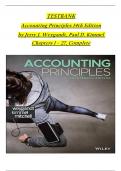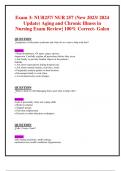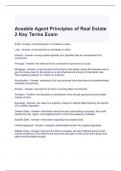TESTBANK
Accounting Principles 14th Edition
by Jerry J. Weygandt, Paul D. Kimmel
Chapters 1 - 27, Complete
,TABLE OF CONTENTS
1 Accounting in Action
2 The Recording Process
3 Adjusting the Accounts
4 Completing the Accounting Cycle
5 Accounting for Merchandising Operations
6 Inventories
7 Accounting Information Systems
8 Fraud, Internal Control, and Cash
9 Accounting for Receivables
10 Plant Assets, Natural Resources, and Intangible Assets
11 Current Liabilities and Payroll Accounting
12 Accounting for Partnerships
13 Corporations: Organization and Capital Stock
Transactions
14 Corporations: Dividends, Retained Earnings, and
Income Reporting
,15 Long-Term Liabilities
16 Investments
17 Statement of Cash Flows
18 Financial Analysis: The Big Picture
19 Managerial Accounting
20 Job Order Costing
21 Process Costing
22 Cost-Volume-Profit
23 Incremental Analysis
24 Budgetary Planning
25 Budgetary Control and Responsibility Accounting
26 Standard Costs and Balanced Scorecard
27 Planning for Capital Investments
,CHAPTER 1
ACCOUNTING IN ACTION
CHAPTER LEARNING OBJECTIVES
1. Identify the activities and users associated with accounting. Accounting is an information system
that identifies, records, and communicates the economic events of an organization to interested
users. The major users and uses of accounting are as follows: (a) Management uses accounting
information to plan, organize, and run the business. (b) Investors (owners) decide whether to
buy, hold, or sell their financial interests on the basis of accounting data. (c) Creditors (suppliers
and bankers) evaluate the risks of granting credit or lending money on the basis of accounting
information. Other groups that use accounting information are taxing authorities, regulatory
agencies, customers, and labor unions.
2. Explain the building blocks of accounting: ethics, principles, and assumptions. Ethics are the
standards of conduct by which actions are judged as right or wrong. Effective financial reporting
depends on sound ethical behavior.
Generally accepted accounting principles are a common set of standards used by accountants.
The primary accounting standard-setting body in the United States is the Financial Accounting
Standards Board.
3. State the accounting equation, and define its components. The basic accounting equation is:
Assets = Liabilities + Owner's Equity
Assets are resources a business owns. Liabilities are creditorship claims on total assets.Owner's
equity is the ownership claim on total assets.
The expanded accounting equation is:
Assets Liabilities + Owner's Capital Owner's Drawings + Revenues
Expenses
Investments by owners (assets the owner puts into the business) are recorded in a category
called owner‘s capital. Owner‘s drawings are the withdrawal of assets by the owner for personal
use. Revenues are the gross increase in owner‘s equity from business activities for the purpose of
earning income. Expenses are the costs of assets consumed or services used in the process of
earning revenue. Owner‘s equity is increased by an owner‘s investments and by revenues from
business operations. Owner‘s equity is decreased by an owner‘s withdrawals of assets and by
expenses.
4. Analyze the effects of business transactions on the accounting equation. Each business
transaction must have a dual effect on the accounting equation. For example, if an individual
asset increases, there must be a corresponding (1) decrease in another asset, or (2) increase in a
specific liability, or (3) increase in owner's equity.
5. Describe the four financial statements and how they are prepared. An income statement presents
the revenues and expenses, and resulting net income or net loss for a specific period of time. An
owner's equity statement summarizes the changes in owner's equity for a specific period of time.
A balance sheet reports the assets, liabilities, and owner's equity at a specific date. A statement of
cash flows summarizes information about the cash inflows (receipts) and outflows (payments)
for a specific period of time.
,
,21A - 2 Test Bank for Accounting Principles, Fourteenth Edition
a
6. Explain the career opportunities in accounting. Accounting offers many different jobs in fields
such as public and private accounting, governmental, and forensic accounting. Accounting is a
popular major because there are many different types of jobs, with unlimited potential for career
advancement.
, Process Costing21A - 3
TRUE-FALSE STATEMENTS
1. Owners of business firms are the only people who need accounting information.
Ans: F, LO: 1, Bloom: K, Difficulty: Easy, Min: 1, AACSB: None, AICPA BB: Governance Perspective, AICPA FC: Reporting, AICPA PC: None, IMA: Reporting
2. Transactions that can be measured in dollars and cents are recorded in the financial
information system.
Ans: T, LO: 1, Bloom: K, Difficulty: Easy, Min: 1, AACSB: None, AICPA BB: Governance Perspective, AICPA FC: Measurement Analysis and
Interpretation, AICPA PC: None, IMA: Reporting
3. The hiring of a new company president is an economic event recorded by the financial
information system.
Ans: F, LO: 1, Bloom: C, Difficulty: Easy, Min: 1, AACSB: None, AICPA BB: Governance Perspective, AICPA FC: Measurement Analysis and
Interpretation, AICPA PC: None, IMA: Reporting
4. Management of a business enterprise is the major external user of information.
Ans: F, LO: 1, Bloom: K, Difficulty: Easy, Min: 1, AACSB: None, AICPA BB: Governance Perspective, AICPA FC: Measurement Analysis and
Interpretation, AICPA PC: None, IMA: Reporting
5. Accounting communicates financial information about a business enterprise to bothinternal
and external users.
Ans: T, LO: 1, Bloom: K, Difficulty: Easy, Min: 1, AACSB: None, AICPA BB: Governance Perspective, AICPA FC: Measurement Analysis and
Interpretation, AICPA PC: None, IMA: Reporting
6. Accounting information is used only by external users with a financial interest in abusiness
enterprise.
Ans: F, LO: 1, Bloom: C, Difficulty: Easy, Min: 1, AACSB: None, AICPA BB: Governance Perspective, AICPA FC: Measurement Analysis and
Interpretation, AICPA PC: None, IMA: Reporting
7. Financial statements are the major means of communicating accounting information to
interested parties.
Ans: T, LO: 1, Bloom: K, Difficulty: Easy, Min: 1, AACSB: None, AICPA BB: Governance Perspective, AICPA FC: Measurement Analysis and
Interpretation, AICPA PC: None, IMA: Reporting
8. Bookkeeping and accounting are one and the same because the bookkeeping function
includes the accounting process.
Ans: F, LO: 1, Bloom: C, Difficulty: Easy, Min: 1, AACSB: None, AICPA BB: Governance Perspective, AICPA FC: Measurement Analysis and
Interpretation, AICPA PC: None, IMA: Reporting
9. The origins of accounting are attributed to Luca Pacioli, a famous mathematician.
Ans: T, LO: 1, Bloom: K, Difficulty: Easy, Min: 1, AACSB: None, AICPA BB: Governance Perspective, AICPA FC: Measurement Analysis and
Interpretation, AICPA PC: None, IMA: Reporting
,21A - 4 Test Bank for Accounting Principles, Fourteenth Edition
10. The study of accounting is not useful for a business career unless your career objective isto
become an accountant.
Ans: F, LO: 1, Bloom: K, Difficulty: Easy, Min: 1, AACSB: None, AICPA BB: Governance Perspective, AICPA FC: Measurement Analysis and Interpretation,
AICPA PC: None, IMA: Reporting
11. A working knowledge of accounting is not relevant to a lawyer or an architect.
Ans: F, LO: 1, Bloom: K, Difficulty: Easy, Min: 1, AACSB: None, AICPA BB: Governance Perspective, AICPA FC: Measurement Analysis and Interpretation,
AICPA PC: None, IMA: Reporting
12. Identifying is the process of keeping a chronological diary of events measured in dollars
and cents.
Ans: F, LO: 1, Bloom: K, Difficulty: Easy, Min: 1, AACSB: None, AICPA BB: Governance Perspective, AICPA FC: Measurement Analysis and Interpretation,
AICPA PC: None, IMA: Reporting
13. Management consulting includes examining the financial statements of companies and
expressing an opinion as to the fairness of their presentation.
Ans: F, LO: 1, Bloom: K, Difficulty: Easy, Min: 1, AACSB: None, AICPA BB: Governance Perspective, AICPA FC: Measurement Analysis and Interpretation,
AICPA PC: None, IMA: Reporting
14. A partnership must have more than one owner.
Ans: T, LO: 2, Bloom: K, Difficulty: Easy, Min: 1, AACSB: None, AICPA BB: Governance Perspective, AICPA FC: Measurement Analysis and Interpretation,
AICPA PC: None, IMA: Reporting
, Process Costing21A - 5
15. The economic entity assumption requires that the activities of an entity be kept separate
and distinct from the activities of its owner and all other economic entities.
Ans: T, LO: 2, Bloom: K, Difficulty: Easy, Min: 1, AACSB: None, AICPA BB: Governance Perspective, AICPA FC: Measurement Analysis and
Interpretation, AICPA PC: None, IMA: Reporting
16. The monetary unit assumption states that transactions that can be measured in terms of
money should be recorded in the accounting records.
Ans: T, LO: 2, Bloom: K, Difficulty: Easy, Min: 1, AACSB: None, AICPA BB: Governance Perspective, AICPA FC: Measurement Analysis and
Interpretation, AICPA PC: None, IMA: Reporting
17. Accountants rely on a fundamental business concept—ethical behavior—in reporting
financial information.
Ans: T, LO: 1, Bloom: K, Difficulty: Easy, Min: 1, AACSB: None, AICPA BB: Governance Perspective, AICPA FC: Measurement Analysis and
Interpretation, AICPA PC: None, IMA: Reporting
18. The primary accounting standard-setting body in the United States is the International
Accounting Standards Board.
Ans: F, LO: 2, Bloom: K, Difficulty: Easy, Min: 1, AACSB: None, AICPA BB: Governance Perspective, AICPA FC: Measurement Analysis and
Interpretation, AICPA PC: None, IMA: Reporting
19. The Financial Accounting Standards Board is a part of the Securities and Exchange
Commission.
Ans: F, LO: 2, Bloom: K, Difficulty: Easy, Min: 1, AACSB: None, AICPA BB: Governance Perspective, AICPA FC: Measurement Analysis and
Interpretation, AICPA PC: None, IMA: Reporting
20. The Securities and Exchange Commission oversees U.S. financial markets andaccounting
standard-setting bodies.
Ans: T, LO: 2, Bloom: K, Difficulty: Easy, Min: 1, AACSB: None, AICPA BB: Governance Perspective, AICPA FC: Measurement Analysis and
Interpretation, AICPA PC: None, IMA: Reporting
21. The cost and fair market value of an asset are the same at the time of acquisition and inall
subsequent periods.
Ans: F, LO: 2, Bloom: K, Difficulty: Easy, Min: 1, AACSB: None, AICPA BB: Governance Perspective, AICPA FC: Measurement Analysis and
Interpretation, AICPA PC: None, IMA: Reporting
22. Even though a partnership is not a separate legal entity, for accounting purposes the
partnership affairs should be kept separate from the personal activities of the owners.
Ans: T, LO: 2, Bloom: C, Difficulty: Easy, Min: 1, AACSB: None, AICPA BB: Governance Perspective, AICPA FC:
Measurement Analysis and Interpretation, AICPA PC: None, IMA: Reporting
23. Accountants do not have to worry about issues of ethics.
Ans: F, LO: 2, Bloom: K, Difficulty: Easy, Min: 1, AACSB: Ethics, AICPA BB: Governance Perspective, AICPA FC: Measurement Analysis and
Interpretation, AICPA PC: Professional Behavior, IMA: Reporting
24. At the time an asset is acquired, cost and fair value should be the same.
, 21A - 6 Test Bank for Accounting Principles, Fourteenth Edition
Ans: T, LO: 2, Bloom: C, Difficulty: Easy, Min: 1, AACSB: None, AICPA BB: Governance Perspective, AICPA FC: Measurement Analysis and Interpretation,
AICPA PC: None, IMA: Reporting
25. The monetary unit assumption requires that all dollar amounts be rounded to the nearest
dollar.
Ans: F, LO: 2, Bloom: K, Difficulty: Easy, Min: 1, AACSB: None, AICPA BB: Governance Perspective, AICPA FC: Measurement Analysis and Interpretation,
AICPA PC: None, IMA: Reporting
26. In order to possess future service potential, an asset must have physical substance.
Ans: F, LO: 3, Bloom: K, Difficulty: Easy, Min: 1, AACSB: None, AICPA BB: Governance Perspective, AICPA FC: Measurement Analysis and Interpretation,
AICPA PC: None, IMA: Reporting
27. Owners' claims to total business assets take precedence over the claims of creditors
because owners invest assets in the business and are liable for losses.
Ans: F, LO: 3, Bloom: K, Difficulty: Easy, Min: 1, AACSB: None, AICPA BB: Governance Perspective, AICPA FC: Measurement Analysis and Interpretation,
AICPA PC: None, IMA: Reporting
28. The basic accounting equation states that Assets = Liabilities.
Ans: F, LO: 3, Bloom: K, Difficulty: Easy, Min: 1, AACSB: None, AICPA BB: Governance Perspective, AICPA FC: Measurement Analysis and Interpretation,
AICPA PC: None, IMA: Reporting






